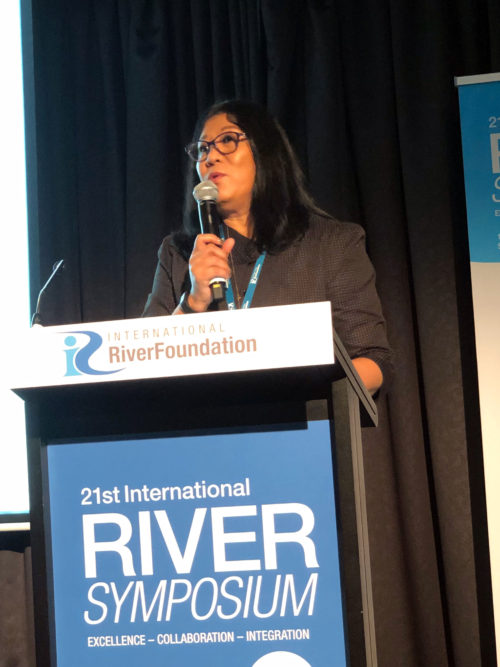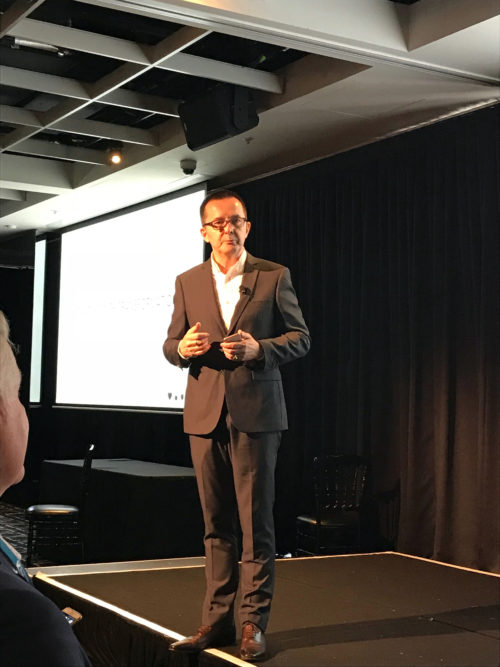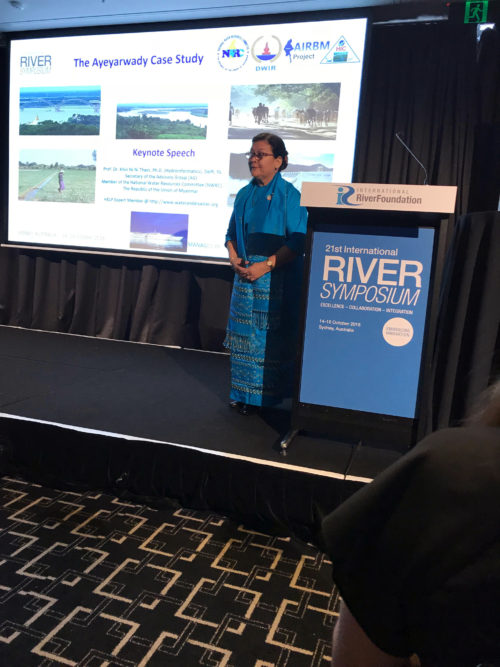The 21st International Riversymposium
Bill Dennison ·The 21st annual International Riversymposium was held in Doltone House, Sydney, Australia 14-18 October 2018. I enjoyed the location right on the shore of Sydney Harbour and the food was superb. The theme of this year’s Riversymposium was ‘Embracing Innovation’. The Symposium featured a welcome river cruise, four keynote talks, a series of interactive ‘Learn-Inspire-Transform’ sessions, standard contributed papers, the Riverprize Gala Dinner, a keynote panel discussion, and day-long study tours.
My contribution was to present one of the keynote talks, entitled ‘Creating and communicating environmental intelligence’, to co-host the Riverprize Gala Dinner with Dr. Eva Abal, and to help out with the Learn-Inspire-Transform session, entitled ‘Inclusive approaches to integrate streams, build environmental intelligence, and engage stakeholders’. These activities made for a busy symposium for me.

In the opening session, Rod Simpson, the Environment Commissioner from the Greater Sydney Commission, introduced us to the Sydney region with a nice summary. He identified three cities: 1) the expanding ‘Parkland City’ in the western Sydney suburbs, 2) the ‘River City’ centered around the Parramatta River and 3) the ‘Harbour City’ surrounding Sydney Harbour and containing iconic features like the Sydney Opera House, Sydney Harbour Bridge, Manly ferries, and beautiful vistas.

I very much enjoyed my fellow keynote speakers. Prof. Rebekah Brown from Monash University talked about her personal journey of starting from natural sciences and embracing social sciences. She leads an ambitious international research program named ‘Revitalising Informal Settlements and their Environments’ (RISE), funded by the Wellcome Foundation. Rebekah made the point that informal settlements, aka slums, are the ‘new normal’. There are about 1 billion people living in informal settlements, 2.3 billion people without adequate sanitation, and over 560,000 children die every year from waterborne diseases. Rebekah showed an example of installing outhouses that provided more safety and dignity to women who would only use latrines at night due to modesty, which put them into danger. She made five recommendations: 1) forge a bold and inclusive mission, 2) develop ‘T-shaped’ researchers who have breadth and depth, 3) nurture constructive dialog, 4) bridge research, policy, and practice, and 5) give institutional support.

Wouter Lincklaen Arriens, the founder and CEO of TransformationFirst.Asia, used the program Mentimeter to hold a very interactive session. The audience signed in to the Mentimeter website so that we could respond to each slide that Wouter presented with a) a heart to signify you love it, b) a thumbs up to signify you agree with it, or c) a kitten to signify that you would like to play with the concept. In addition, you could ask a question online and the program allowed people to vote on each question, helping Wouter prioritize the questions. Mentimeter also allowed us to answer questions and display the responses immediately. We also created a word cloud to Wouter’s question of “What will it take to double your vision?” The most popular answers were time, passion, collaboration, courage, and money. A book that Wouter recommended was What Got You Here Won’t Get You There, by Marshall Goldsmith. He also advocated the 70-20-10 rule for leadership development: 70% from challenging assignments, 20% from coaching and mentoring, and 10% from structured learning.

Prof. Ni Ni Thein from Myanmar, aka Burma, talked about the Irrawaddy, aka Ayearwady, River--Myanmar’s largest river and one of the world’s largest free-flowing rivers. The watershed of the Irrawaddy River is 91% agriculture, 6% domestic, and 3% industrial. Prof. Ni Ni talked about the principles of fairness, trust, and peace. The value of the Irrawaddy River is connected to the national spirit of Myanmar and considered to be priceless. The value of the Irrawaddy River basin is in the societal value of livelihoods, development, and biodiversity. Prof. Ni Ni indicated that the Irrawaddy River is a twinning partner of Australian’s Murray-Darling River system. She also highlighted the new state of the river report.

There were many interesting talks. I especially enjoyed Angela Arthington’s update of the Brisbane Declaration, a 2007 co-authored statement about environmental flows developed in the 2007 International Riversymposium. At the 2017 International Riversymposium, a team led by Angela revised and updated the Brisbane Declaration. I enjoyed watching Michael Douglas present a talk and video, called “Talking together, working together, walking together”, with his Traditional Owner partners Mona Liddy, Kurt Liddy, and Lizzie Sullivan.
There were two Riverprizes awarded this year. The Bert and Vera Thiess Foundation Australasia Riverprize was awarded to the Whangawehi Stream in New Zealand, with Laidley Creek in Queensland and the Parramatta River in New South Wales as finalists. The inaugural Asia Riverprize was awarded to the Pasig River in the Philippines, with the Yangtze River in China as a finalist. Both Riverprize recipient teams were extremely excited and vocal about winning.

For the finale of the Symposium, I offered the following song:
What a Wonderful River
William C. Dennison
17 October 2018
I see people who care, real passion too
I see them share for me and you
And I think to myself what a wonderful river
I see rivers that run blue and the thoughts of many
The bright young women, the old wise men
And I think to myself what a wonderful river
The smiles on the faces so pretty in this room
Are also on the faces of people going by
I see friends shaking hands saying how do you do
They're really saying I love you
I hear panelists sharing, I watch us grow
We'll learn much more than we'll never know
And I think to myself what a wonderful world
Yes, I think to myself what a wonderful world
About the author
Bill Dennison

Dr. Bill Dennison is a Professor of Marine Science and Vice President for Science Application at the University of Maryland Center for Environmental Science.

